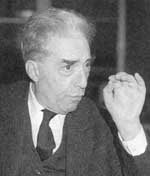|
|
Luigi Dallapiccola
Gavin Thomas introduces the work of Luigi Dallapiccola (1904--1975).
Overview
The theme of human liberty and subjection is a recurrent
feature of both Dallapiccola’s life and music.
Born in 1904 in Pisino, Istria, an ethnically Italian region
of the Austro-Hungarian Empire, Dallapiccola was just ten years old
when he and his family were interned in Graz after the Austrian
authorities began to suspect his father of Italian nationalist leanings --
an early and formative experience of the fate of political and
racial minoritities living under an authoritarian regime.
Nevertheless, although the forced removal disrupted the young Dallapiccola’s
musical education, it was in Graz that he heard the performance
of Wagner’s Flying Dutchman which made him determined to become a composer, and
in 1923 he entered the Florence Conservatory, an institute with would
he would maintain a lifelong connection.
Dallapiccola’s early works show him grappling with a range of disparate
influences -- Debussy especially, along with earlier Italian composers such as
Monteverdi and Gesualdo -- while a performance of Schoenberg’s Pierrot Lunaire
in Florence in 1924 kindled his interest in the music of the Second Viennese School.
A decade of study and musical consolidation followed. In 1934,
he was appointed a professor of piano at the Florence
Conservatory, a post he held until his retirement in
1967, while his own compositions continued to develop under the influences of
Busoni, Schoenberg and, especially, Berg,
as Dallapiccola studied the 12-note system and began to incorporate
it into his own music.
Meanwhile, the growing shadow of Fascism reawakened his concern with
the plight of ordinary human beings living under despotism.
In 1938, Mussolini’s adoption of Hitler’s racial policies (with the
consequent threat to Dallapiccola’s own wife, who was Jewish) provided
the impetus for the first of his tryptych of
works concerned with imprisonment and freedom, the Canti di prigionia
(“Songs of Imprisonment”) -- as Dallapiccola noted in his diary:
“in a totalitarian regime the individual is powerless.
Only by means of music would I be able to express my anger.”
Dallapiccola’s public opposition to Mussolini made his position increasingly
untenable until, during 1942--44, he was forced first
out of Florence and eventually into hiding in the countryside.
For
all his personal difficulties, however, the years immediately before and during World
War II were musically fecund ones, as Dallapiccola
established the lyrical version of 12-note music -- with
a distinctly Italian turn of phrase -- that was to serve him
for the remainder of his career, and which he
first expounded in the sequence of small-scale vocal works, most notably
the Liriche greche, written during the 1940s.
As a well-known opponent of Fascism, Dallapiccola emerged from the aftermath
of war with his personal reputation enhanced, while the premiere in
1950 of his most famous work, the opera Il prigioniero,
established his international reputation as the leading Italian composer of
his generation.
Despite this, as his public fame increased, so his musical
style became increasingly abstract and personal, eschewing big public statements in
favour of a lyrical understatement, as exemplified by the
third of his “prisoner” pieces, the Canti di liberazione
(“Songs of Freedom”) of 1955.
Article and review pages originally published in The Rough Guide
to Classical Music
|